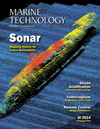
Page 41: of Marine Technology Magazine (March 2014)
Instrumentation: Measurement, Process & Analysis
Read this page in Pdf, Flash or Html5 edition of March 2014 Marine Technology Magazine
capability. UCS repackages that soft- ware into an open standard that is well- known, that isn?t commercialized, that industry recognizes and thereby opens our competition and it opens the ability for third parties to add capability.? ?Our vision is an architecture that is exible enough to range from our small UAS and OSRVT (One System Remote Video Terminal), through our large UAS and the ground control station,? said Kennedy. According to Ernst, UCS breaks up the different ground control segment functionalities, which allows for inser- tion of new capabilities and upgrading of legacy capabilities?such as route planning, weather services, task moni-toring or ight status monitoring that most GCS have to implement?without having to rebuild the entire GCS. ?It?s ?plug and play? for GCS development.? Legacy systems can be adapted for UCS, and are then able to take advan- tage of the many bene ts of UCS. This helps to protect an investment in a sys- tem, and can prolong the service life of the system by adding new capability. The software from the Army Bi- Directional Remote Video Transceiver (BDRVT), which is an enhanced ver- sion of the Army?s One System Remote Video Transceiver (OSRVT) (made by AAI Corporation to support video and telemetry from a number of UAS such as Shadow, Predator, Pioneer and oth- ers), was used to demonstrate how UCS works. One experiment was conducted by the Navy. ?BDRVT was totally integrated software,? said Wayne Perras, UCS project manager at the Of ce of Naval Research (ONR). ?We broke it up into services and rewrote those services into UCS in two different codes. Then we combined the services back together again to see if we can have that same BDRVT to prove that that it operates vehicles.? ?We showed that we?ve got interoper- ability by having it built and written in a different code, and being able to ex- change or replace services while con-tinuing to operate at the same perfor- mance,? Perras said. Then the Army ight-tested the UCS-compliant BDRVT with an AAI Corpo- ration Shadow reconnaissance UAS. ?We took a bidirectional capability, put it into an open architecture model which was compliant with the UCS standards and demonstrated that the open model could, in fact, address the bidirectional capability that we?re look- ing to put into our systems,? said Ken- nedy. The ight-test using an Army Shadow UAS was a success. ?It was so success- ful that we have moved our whole OS- www.seadiscovery.com Marine Technology Reporter 41MTR #2 (34-49).indd 41MTR #2 (34-49).indd 412/21/2014 11:09:59 AM2/21/2014 11:09:59 AM

 40
40

 42
42
